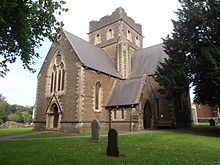|
St Margaret's Church, Roath
St Margaret's Church (Welsh: Eglwys y Santes Fererid, dedicated to St Margaret of Antioch) is a nineteenth-century Church in Wales parish church in the suburb of Roath, Cardiff, Wales. It includes the mausoleum of the Marquises of Bute. HistoryA church dedicated to St Margaret existed in Roath since the medieval period. It was a small Perpendicular style building with a bell-turret at the western end.[1] In 1800 a mausoleum was added, for the Marquises of Bute.[2] The church was completely demolished in 1868 to make way for a new replacement.[1] The new church was completed, with a cruciform plan in a Decorated Gothic style.[1] The plan had been designed by Alexander Roos, architect to the Butes. The above ground church was designed by architect John Prichard and financed by John Crichton-Stuart, 3rd Marquess of Bute, who dismissed Roos when he came of age in 1868.[3] A wide variety of coloured bricks and coloured stone was used to decorate the internal walls, in red, blue, white, grey-green and pink.[3] The church tower (without the spire envisaged by Prichard) was designed later by John Coates Carter and completed in 1926.[3] The glasswork of the church's east window was destroyed in a bomb-blast during the Second World War. The present glass, dating from 1952, depicts the Ascension of Jesus, flanked by the patron saints of the four daughter churches: St Edward's, St Anne's, St Agnes's and St Philip's. Of these churches, only St Edward's still holds a daughter position. St Agnes's closed in 1966 and St Anne's in 2015. St Philip is still an operational church, but is no longer in the parish after the boundaries were adjusted in the late 20th century.[4] The church was designated a Grade I listed building in 1975.[5] Bute mausoleumAn ornate north aisle chapel was added to the church between 1881 and 1886,[2] as the new mausoleum for the Bute family tombs.[1] Seven large sarcophagi in red granite, were added to contain the remains of the members of the Bute family who had been interred in the previous church.[6] The original stone memorial plaques were included in the new tombs. Those interred in the sarcophagi are:[6]
Daughter ChurchesSt Margaret's now has only one daughter church, this being the nearby St Edward's on Blenheim Road. It formerly had several others:
Gallery
References
External links |
||||||||||||||||||||||||||||||||||||||||||||||||||




